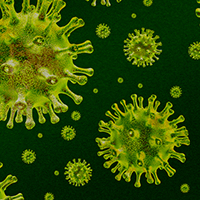Clinical and epidemiological profile of Indian COVID-19 patients from Jaipur: a descriptive study

Submitted: May 13, 2020
Accepted: December 14, 2020
Published: July 21, 2021
Accepted: December 14, 2020
Abstract Views: 1776
PDF: 806
Publisher's note
All claims expressed in this article are solely those of the authors and do not necessarily represent those of their affiliated organizations, or those of the publisher, the editors and the reviewers. Any product that may be evaluated in this article or claim that may be made by its manufacturer is not guaranteed or endorsed by the publisher.
All claims expressed in this article are solely those of the authors and do not necessarily represent those of their affiliated organizations, or those of the publisher, the editors and the reviewers. Any product that may be evaluated in this article or claim that may be made by its manufacturer is not guaranteed or endorsed by the publisher.
Similar Articles
- Muhammad Ijaz, Muhammad Jaffar Khan, Jawad Khan, . Usama, Association of clinical characteristics of patients presenting with influenza like illness or severe acute respiratory illness with development of acute respiratory distress syndrome , Monaldi Archives for Chest Disease: Vol. 87 No. 1 (2017)
- Massimiliano Polastri, Lara Pisani, Andrea Dell'Amore, Stefano Nava, Revolving door respiratory patients: A rehabilitative perspective , Monaldi Archives for Chest Disease: Vol. 87 No. 3 (2017)
- Claudio F. Donner, Sandro Amaducci, Elena Bacci, Sandra Baldacci, Maria L. Bartoli, Gianfranco M. Beghi, Alida Benfante, Sara Brighindi, Lucio Casali, Daniela Castiglia, Mario Cazzola, Alessandro Celi, Silvana Cianchetti, Giorgio Colombo, Claudia Crimi, Federico L. Dente, Giuseppe Di Maria, Annalisa Di Maria, Manuela Latorre, Federico Lavorini, Sara Maio, Claudia Mannini, Riccardo Messina, Pier Luigi Paggiaro, Patrizia Pignatti, David Price, Nicola Scichilone, Marzia Simoni, Antonio Spanevello, Martina Stagno d’Alcontres, Shawna Tan, Roberto Torchio, Giovanni Viegi, Dina Visca, Emiel F.M. Wouters, Shaylynn Yu Hui Xin, Inhalation therapy in the next decade: Determinants of adherence to treatment in asthma and COPD , Monaldi Archives for Chest Disease: Vol. 88 No. 1 (2018)
- Carlos A. Jiménez-Ruiz, Marcos Garcia Rueda, Manuel A. Martinez Muñiz, Jacobo Sellarés, Maria A. Jiménez-Fuentes, Lourdes Lázaro Asegurado, Esther RodrÃguez Gonzalez, Concepción Rodriguez Garcia, Oriol Armengol, Emilia Abad, Teresa Peña, Adolfo Domenech del Rio, Juan A. Riesco Miranda, Varenicline in smokers with severe or very severe COPD after 24 weeks of treatment. A descriptive analysis: VALUE study , Monaldi Archives for Chest Disease: Vol. 87 No. 3 (2017)
- Gabriele Valli, Francesca De Marco, Maria Teresa Spina, Valentina Valeriano, Antonello Rosa, Valentina Minerva, Enrico Mirante, Maria Pia Ruggieri, Francesco Rocco Pugliese, A pilot study on the application of the current European guidelines for the management of acute coronary syndrome without elevation of ST segment (NSTEMI) in the Emergency Department setting in the Italian region Lazio , Monaldi Archives for Chest Disease: Vol. 82 No. 4 (2014): Cardiac series
- Roberto Porta, Laura Comini, Luca Barbano, Luca Bianchi, Michele Vitacca, A case of obstructive sleep apnea syndrome associated with floppy eyelid syndrome: positive effect of CPAP therapy , Monaldi Archives for Chest Disease: Vol. 87 No. 1 (2017)
- Francesco Barillà , Concetta Torromeo, Riccardo Iorio, Luigina Porco, Vincenzo Paravati, Carlo Gaudio, Antiplatelet therapy in elderly patients with acute coronary syndrome: Between scientific evidence and future perspectives , Monaldi Archives for Chest Disease: Vol. 88 No. 2 (2018)
- Vishal Chopra, Hardik Jain, Akhil D. Goel, Siddharth Chopra, Ashrafjit S. Chahal, Neha Garg, Vidhu Mittal, Correlation of aspergillus skin hypersensitivity with the duration and severity of asthma , Monaldi Archives for Chest Disease: Vol. 87 No. 3 (2017)
- Samuele Baldasseroni, Alessandra Pratesi, Francesco Orso, Claudia Di Serio, Alice Foschini, Andrea Giosafat Marella, Nadia Bartoli, Mauro Di Bari, Stefano Fumagalli, Niccolò Marchionni, Francesca Tarantini, Epicardial adipose tissue and insulin resistance in patients with coronary artery disease with or without left ventricular dysfunction , Monaldi Archives for Chest Disease: Vol. 80 No. 4 (2013): Cardiac Series
- D.S.C. Hui, An overview on Severe Acute Respiratory Syndrome (SARS) , Monaldi Archives for Chest Disease: Vol. 63 No. 3 (2005): Pulmonary series
You may also start an advanced similarity search for this article.

 https://doi.org/10.4081/monaldi.2021.1377
https://doi.org/10.4081/monaldi.2021.1377





